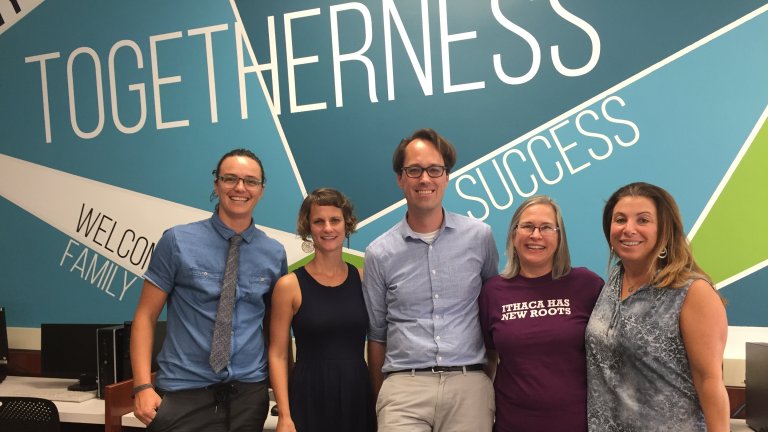Caption: ECS Founder and Executive Director, Alison Diaz, meets with educators to share about Environmental Charter Schools’ best practices.
Originally posted on Teaching Our Cities Blog
By Alison Diaz and Sammy Lyon
We walked into what we thought would be a crisp fall day in Boston, but instead was a sweltering humid 80+ degrees at the end of September. We were coming all the way from Los Angeles to meet up with educators and students from up and down the East Coast, all of us sweating together in the beautiful library of Boston Green Academy for a day of sharing, learning and inspiration.
A year and a half ago Joel Tolman from Common Ground High School asked us if we wanted to be advisors to an ambitious new project. With initial funding by the EPA, Teaching Our Cities planned to bring five schools together over the course of a year to share in a community of practice around environmentally-themed, interdisciplinary urban education.
We’ve been to many conferences, workshops and summits, but we’ve never been to anything like this. We gathered with educators, principals and students from five schools — New Roots Charter School, The Greene School, Boston Green Academy, Connecticut River Academy and Common Ground High School — who have committed to a year of improving their practice in a range of areas, from interdisciplinary units to student portfolios to building a staff culture of sustainability.
Each school had applied to be a part of this cohort by presenting a “problem of practice” — not just one lesson or unit they wanted to work on, but a schoolwide approach. We were excited to find we had peers who were deeply engaged in developing real-world learning for students, not only in one or two classrooms but as a schoolwide commitment to engaging students in the rich resources of our communities. At the convening, we saw examples of interdisciplinary learning with authentic assessments — creating units around an essential question culminating in a demonstration of student learning. Simply put, this kind of innovative, real-world learning is not something many schools attempt to do…and here were five schools doing it! Together they were struggling through the hard issues, tackling the challenges and working to improve instruction for all students. For almost two decades, we felt alone in our work of creating communities of practice within our schools. At Teaching Our Cities, we found out we are definitely not alone.
After many years of developing similar learning opportunities that prepare students for college and community stewardship, our team at Environmental Charter Schools (ECS) in Los Angeles set out to codify those practices into a best practices framework — a teacher designed rubric to guide our work. These five Best Practices have evolved into a comprehensive Teacher Development & Evaluation rubric that we use across all 3 of our schools, but it didn’t happen overnight. We had the opportunity to share these Best Practices with educators at Teaching Our Cities in Boston.
Here’s how the ECS Best Practices evolved over time:
Founded in 2000, ECS was based upon the California Partnership Academy’s four Best Practices: Small Learning Communities, Rigorous Interdisciplinary College-Prep Curriculum, Partnerships, and Using a Career Theme (ours being using the Environment as the integrating context).
The Early Years: Student Focused (2000 – 2010)
Starting out, we created several structures in which our best practices could thrive. We created space in our instructional calendar for a team of teachers to have the same students, which allowed all students to engage in an interdisciplinary unit. We aligned our program with our goal that all students have access to college. To bring this to fruition, we adopted a College-Prep course that was scoped and sequenced for grades 6-12. Two other program pieces were added to bookend a student’s experience:
Green Ambassadors: a required class in which students learn to take action to solve an environmental challenge, and
Senior Thesis: a graduation requirement and the last course in the college prep course sequence, in which students research a social or environmental injustice and then take action to solve it!
A Focus on Instruction (2010 – 2014)
As we created a first draft of our teacher development and evaluation rubric, we realized we were missing a best practice. Our best practices talked to curriculum but not instruction. So we added a practice and four became five best practices:
1. Small Learning Communities
2. Interdisciplinary Curriculum & Authentic Assessment
3. Relevant & Engaging Instruction
4. Environmental & Experiential Learning
5. Collaboration With Partners

Establishing Common Ground (2014 – Present)
After expanding from one to three schools, it became clear we needed our whole organization to get on the same page. We underwent a strategic planning process and laid the groundwork for the next 3 years, with one of our main focuses being: “Becoming Masters of our Own Best Practices.”
Part of becoming masters of our own best practices meant that we needed to establish a clear understanding of what it looks like to be an ECS instructor, and how to evaluate teachers on their implementation of our best practices. We wanted our teachers and leaders to be on the same page about what good instruction looks like, while documenting what we were doing so that new and existing teachers could improve.
Revising our Rubric
The first step was to create a rubric. A team of ECS teacher leaders and administrators worked to develop our very own Teacher Development and Evaluation (TDE) rubric using the Danielson and Marzano frameworks for guidance. In addition to the rubric, we also set the intention to provide examples of what the practice looked like in the classroom at each level. So in addition to implementing the rubric, we set up the following:
– Assigned an instructional coach to every teacher to offer help and catch the best practices in action at ECS!
– Implemented a Rater Training Program to ensure valid and reliable scoring across classrooms.
– Adopted Teachboost to provide immediate feedback to teachers and allow us to easily analyze scores, identify areas of strength and supports needed.

See the ECS Best Practices rubric overview.
Building Reliability and Confidence in the System
With this new system, our biggest concern was whether teachers would accept and put their faith in this more formalized system. We put a lot of time into defining what a level 1 vs level 4 performance was and surveyed our teachers throughout the entire process. After 3 years, 80% of teachers feel that our teacher evaluation system and rubric is valid and reliable, and want to grow and develop into Level 4 teachers.
Show, Don’t Tell
At ECS, we remain committed to continual improvement, including that of our TDE rubric. After implementation and adoption we recognized the need to provide concrete examples of what each best practice would look like in practice. Our goal was, and still is, to be able to answer the questions “What does this look like in a classroom? Why do we have this best practice?” and “What do students get out of it that makes it worth it?”
In 2017 we implemented a Documentation Project that will create a teacher-led case study that exemplifies each best practice, starting with Environmental & Experiential Learning, after which we will tackle the other four Best Practices.
Teaching Our Cities Takeaways
We came away from our experience at Teaching Our Cities inspired by fellow educators and grateful to share where we stand after 17 years of work. In those years we have learned that we must be deliberate at every step of the way as we create learning opportunities that use the environment to engage students and connect them to the wider world. Has it been worth it? Absolutely. Perhaps the best part was knowing that there are so many other committed colleagues doing the messy and hard work from coast to coast and we look forward to sharing together far into the future.






